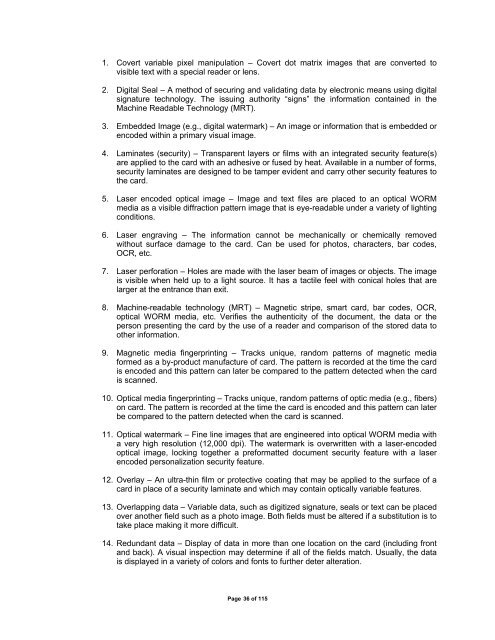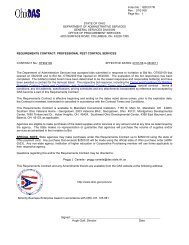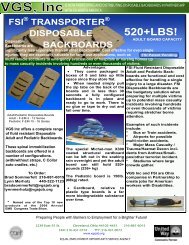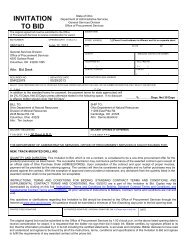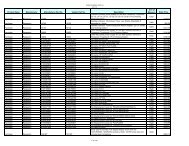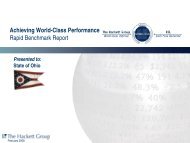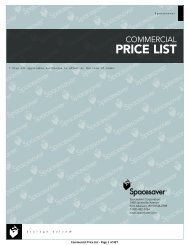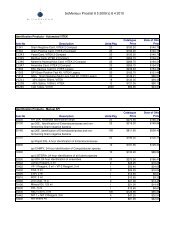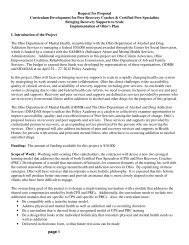REQUEST FOR PROPOSALS RFP NUMBER: 0A1031 DATE ISSUED
REQUEST FOR PROPOSALS RFP NUMBER: 0A1031 DATE ISSUED
REQUEST FOR PROPOSALS RFP NUMBER: 0A1031 DATE ISSUED
Create successful ePaper yourself
Turn your PDF publications into a flip-book with our unique Google optimized e-Paper software.
1. Covert variable pixel manipulation – Covert dot matrix images that are converted to<br />
visible text with a special reader or lens.<br />
2. Digital Seal – A method of securing and validating data by electronic means using digital<br />
signature technology. The issuing authority “signs” the information contained in the<br />
Machine Readable Technology (MRT).<br />
3. Embedded Image (e.g., digital watermark) – An image or information that is embedded or<br />
encoded within a primary visual image.<br />
4. Laminates (security) – Transparent layers or films with an integrated security feature(s)<br />
are applied to the card with an adhesive or fused by heat. Available in a number of forms,<br />
security laminates are designed to be tamper evident and carry other security features to<br />
the card.<br />
5. Laser encoded optical image – Image and text files are placed to an optical WORM<br />
media as a visible diffraction pattern image that is eye-readable under a variety of lighting<br />
conditions.<br />
6. Laser engraving – The information cannot be mechanically or chemically removed<br />
without surface damage to the card. Can be used for photos, characters, bar codes,<br />
OCR, etc.<br />
7. Laser perforation – Holes are made with the laser beam of images or objects. The image<br />
is visible when held up to a light source. It has a tactile feel with conical holes that are<br />
larger at the entrance than exit.<br />
8. Machine-readable technology (MRT) – Magnetic stripe, smart card, bar codes, OCR,<br />
optical WORM media, etc. Verifies the authenticity of the document, the data or the<br />
person presenting the card by the use of a reader and comparison of the stored data to<br />
other information.<br />
9. Magnetic media fingerprinting – Tracks unique, random patterns of magnetic media<br />
formed as a by-product manufacture of card. The pattern is recorded at the time the card<br />
is encoded and this pattern can later be compared to the pattern detected when the card<br />
is scanned.<br />
10. Optical media fingerprinting – Tracks unique, random patterns of optic media (e.g., fibers)<br />
on card. The pattern is recorded at the time the card is encoded and this pattern can later<br />
be compared to the pattern detected when the card is scanned.<br />
11. Optical watermark – Fine line images that are engineered into optical WORM media with<br />
a very high resolution (12,000 dpi). The watermark is overwritten with a laser-encoded<br />
optical image, locking together a preformatted document security feature with a laser<br />
encoded personalization security feature.<br />
12. Overlay – An ultra-thin film or protective coating that may be applied to the surface of a<br />
card in place of a security laminate and which may contain optically variable features.<br />
13. Overlapping data – Variable data, such as digitized signature, seals or text can be placed<br />
over another field such as a photo image. Both fields must be altered if a substitution is to<br />
take place making it more difficult.<br />
14. Redundant data – Display of data in more than one location on the card (including front<br />
and back). A visual inspection may determine if all of the fields match. Usually, the data<br />
is displayed in a variety of colors and fonts to further deter alteration.<br />
Page 36 of 115


